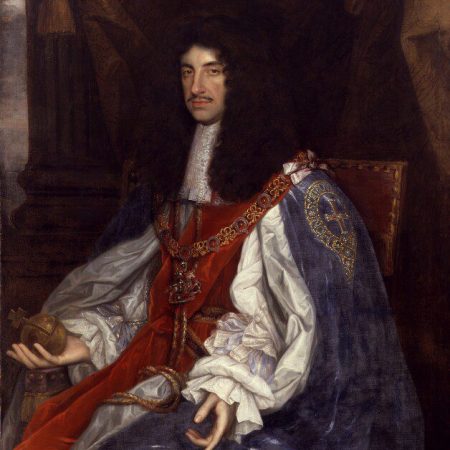On 6 May Charles III will be crowned King of England, Ireland, Scotland, Wales, as well as the Head of the Commonwealth, alongside his Queen Consort, Camilla. Regardless of your views on the modern monarchy, this is a historic event; it is the 40th coronation to be held at Westminster Abbey since 1066 and only the second British coronation to be televised. Charles’ namesakes, Charles I and Charles II, also had notable coronations – in fact, both of his predecessors had two coronations, one in Scotland and one in England. For Charles I, the absence of his wife Henrietta Maria at both events would help shape English history, and the monarchy’s relationship with Catholicism, for centuries to come. For Charles II, his first coronation took place against the backdrop of civil war and did not go as he hoped, and his second, taking place on St George’s Day 1661, marked the Restoration of the monarchy after years spent in exile. The impact of Charles III’s coronation is yet to be seen, but, nevertheless, the upcoming events are linked to those of his predecessors through the very fabric of their surroundings and the regalia being used. This blog explores the material elements connecting the coronations of Charles I, Charles II, and Charles III.
The Coronations of Charles I – 1625 and 1633
In 1625, James VI & I died, leaving his son to inherit, as Charles I. As the Act of Union – which created the United Kingdom of Great Britain – did not take place until 1707, Charles I had coronations in both England and Scotland.[1] His English coronation took place in February 1626 at Westminster Abbey and used the ancient coronation regalia for the last time, parts of which may have dated back to the eleventh century, before they were destroyed after Charles I’s execution in 1649. Unlike the upcoming joint coronation, Charles I was not crowned alongside his wife Henrietta Maria. The Queen’s Catholicism led her to refuse to attend her husband’s coronation, or consent to her own, as these would take place in Protestant churches. Henrietta Maria’s confessional identity caused significant issues, and people were worried that Charles would offer Catholics greater leniency and move away from Protestantism under his wife’s influence.
Charles I’s Scottish coronation took place in 1633 at the Palace of Holyrood in Edinburgh. The ampulla, which held the oil which was used to appoint Charles I at this coronation, can now be found in the National Museum of Scotland.[2] This was used alongside the Honours of Scotland – a crown, sword, and sceptre – which were first united for this purpose for the coronation of Mary Queen of Scots in 1543.[3] This connected Charles with the grandmother he never knew and with his other Scottish royal ancestors who had also used these objects. The Honours are now housed at Edinburgh Castle and, due to the destruction of the English coronation regalia, are now the oldest Crown Jewels in Britain. Whilst Charles I was in Scotland, Henrietta Maria accompanied their daughter Princess Mary to Holland for her marriage to William II of Orange-Nassau. A pamphlet published at the time, Englands Joy and Sorrow, criticised Henrietta Maria and lamented that Charles left England for his northern kingdom, demonstrating that who was, and wasn’t, at a royal coronation, was viewed with much the same interest, and used as an opportunity to criticise and speculate, as it is today.[4]
The Coronations of Charles II – 1651 and 1661
Within days of Charles I’s execution, Charles II was proclaimed king of Scotland, Great Britain, and Ireland from the Mercat Cross in Edinburgh.[5] He was crowned at Scone Palace, in Perth, Scotland, in January 1651. Planning for Charles’ Scottish coronation started in autumn 1650, with the establishment of a coronation committee. Whilst Edinburgh and Stirling were not suitable locations due to Oliver Cromwell’s occupation of the former, and the assumption that his forces would move to occupy the latter, the choice of Scone for the event also reflected Scottish tradition and mythology. Whilst the Stone of Scone had already been taken from Scotland to Westminster Abbey by Edward I in 1296, this location was nevertheless important.[6] At his Scottish coronation Charles II used the Honours of Scotland which were then hidden due to the advance of Cromwell’s army. The Scots were then defeated at the Battle of Worcester and Charles II fled into exile, going first to France.
By 1660, the English Republic, most notably led by Oliver and Richard Cromwell, had ended and Charles II was invited back to England to restore the monarchy. Charles II planned his return carefully, arriving in London on his 30th birthday, May 29, 1660, and his second coronation took place on St George’s Day in 1661 at Westminster Abbey. Whilst this date allowed the coronation to connect Charles to England’s patron saint, it also allowed time for the new coronation regalia to be made.[7] Although negotiations were already underway, Charles II was not yet married to his future wife Catherine of Braganza and thus she was not present at his coronation. Like her mother-in-law, when Catherine did arrive in England in May 1662, she could not have her own coronation due to her Catholicism.
Modern Coronations – the Stone of Scone and the Honours of Scotland
So, how do these four seventeenth century coronations connect to the upcoming coronation of Charles III? Not only does Charles III share a name with these two Stuart kings, but he will also be crowned in Westminster Abbey just as they were, sitting above the Stone of Scone, just as they did for their English coronations. The stone, returned to Scotland in 1996, is now on permanent display at Edinburgh Castle but will be sent to Westminster and placed beneath the coronation chair for the event. Furthermore, the ampulla originally made for the Westminster Abbey coronation of Charles II will now be used to anoint Charles III.[8]
Whilst Charles III will only have one official coronation, there will be a second ceremony in Scotland at St Giles Cathedral where he will be presented with the Honours of Scotland. A similar event took place after Elizabeth II’s coronation, but before that the Honours had been locked away after the 1707 Act of Union and not used in this official capacity.[9] This use of the Honours in a ceremony for Elizabeth II and Charles III can be seen to reflect the concerns expressed during the lifetimes of Charles I and Charles II that both England and Scotland should have their own events to formally confirm, accept, and celebrate the new monarch.
The use of these historic objects binds the monarchs of the past and present together and are used for this very purpose, to explicitly express the inheritance from one generation to the next and to cement the legitimacy of the new monarch.
Footnotes
[1] Anon, ‘Act of Union 1707’, UK Parliament. Accessed 26 April 2023. https://www.parliament.uk/about/living-heritage/evolutionofparliament/legislativescrutiny/act-of-union-1707/.
[2] Anon, ‘Coronation ampulla of Charles I’, National Museums Scotland. Accessed 26 April 2023. https://www.nms.ac.uk/explore-our-collections/stories/scottish-history-and-archaeology/the-jacobite-challenge/the-jacobite-challenge/coronation-ampulla/#:~:text=He%20ascended%20to%20the%20throne,elaborate%20and%20extravagant%20royal%20tour.
[3] Anon, ‘The Honours of Scotland’, The Royal Household. Accessed 26 April 2023, https://www.royal.uk/honours-scotland.
[4] F Coules, Englands joy and sorrow, (London: 1641).
[5] George William Cullen Gross, ‘1651: The Last Coronation in Scotland—An Anomaly?’, The Court Historian, Volume 26, Issue 3, 2021, 230.
[6] Gross, 233.
[7] Anon, ‘Charles II’, Westminster Abbey. Accessed 26 April 2023. https://www.westminster-abbey.org/abbey-commemorations/royals/charles-ii.
[8] Kate Ng, ’King Charles III coronation: What happens in the sacred anointing ceremony?’ Independent. Accessed 26 April 2023. https://www.independent.co.uk/life-style/royal-family/king-charles-coronation-anointing-ceremony-b2319994.html.
[9] Anon, ‘Honours of Scotland’, Edinburgh Castle. Accessed 26/4/2023. https://www.edinburghcastle.scot/see-and-do/highlights/honours-of-scotland.
Suggested Reading:
Anon, ‘Act of Union 1707’, UK Parliament. Accessed 26 April 2023.
Anon, ‘Charles II’, Westminster Abbey. Accessed 26 April 2023. https://www.westminster-abbey.org/abbey-commemorations/royals/charles-ii.Anon, ‘Coronation ampulla of Charles I’, National Museums Scotland. Accessed 26 April 2023. https://www.nms.ac.uk/explore-our-collections/stories/scottish-history-and-archaeology/the-jacobite-challenge/the-jacobite-challenge/coronation-ampulla/#:~:text=He%20ascended%20to%20the%20throne,elaborate%20and%20extravagant%20royal%20tour.
Anon, ‘Honours of Scotland’, Edinburgh Castle. Accessed 26 April 2023. https://www.edinburghcastle.scot/see-and-do/highlights/honours-of-scotland.
Anon, ‘The Honours of Scotland’, The Royal Household, accessed 26 April 2023, https://www.royal.uk/honours-scotland.Anon, ‘The Last Coronation’, Scone Palace, accessed 26 April 2023, https://www.scone-palace.co.uk/news/the-last-coronation.
Betts, Sarah, ‘Henrietta Maria, “Queen of Tears”?: Picturing and Performing the Cavalier Queen’, in Estelle Paranque (Ed.), Remembering Queens and Kings of Early Modern England and France: Reputation, Reinterpretation, and Reincarnation, (Palgrave Macmillan, 2019).
Coules, F, Englands joy and sorrow, (London: 1641).
Gross, George William Cullen, ‘1651: The Last Coronation in Scotland—An Anomaly?’, The Court Historian, Volume 26, Issue 3, 2021. https://doi.org/10.1080/14629712.2021.1996947.
Ng, Kate, ’King Charles III coronation: What happens in the sacred anointing ceremony?’ Independent. Accessed 26 April 2023. https://www.independent.co.uk/life-style/royal-family/king-charles-coronation-anointing-ceremony-b2319994.html.
Reid, Steven J., The Early Life of James VI: A Long Apprenticeship, 1566-1685, (Birlinn LTD, Edinburgh, 2023).
Places to Visit:
Edinburgh Castle, Edinburgh. https://www.edinburghcastle.scot/
National Museum of Scotland, Edinburgh. https://www.nms.ac.uk/national-museum-of-scotland/
National Portrait Gallery of Scotland, Edinburgh. https://www.nationalgalleries.org/visit/scottish-national-portrait-gallery
Palace of Holyroodhouse, Edinburgh. https://www.rct.uk/visit/palace-of-holyroodhouse.
Scone Palace, Perth. https://www.scone-palace.co.uk/
St Giles Cathedral, Edinburgh. https://www.stgilescathedral.org.uk/
Westminster Abbey, London, England. https://www.westminster-abbey.org/

Author: Amy Saunders
Bio: Amy Saunders is a PhD student at the University of Winchester. Her research explores how early modern English and Scottish monarchs are represented in heritage sites. Her current work focuses on James VI & I, Anna of Denmark, Charles I, Henrietta Maria, Charles II, and Catherine of Braganza, exploring themes including othering, gender, sexuality, religion, parenthood, and conflict.
You can explore Amy’s research further via her LinkTree page which contains a variety of freely available blogs, podcasts, recorded public talks, and open access publications exploring royal studies, heritage reconstructions, and representations in popular culture.

